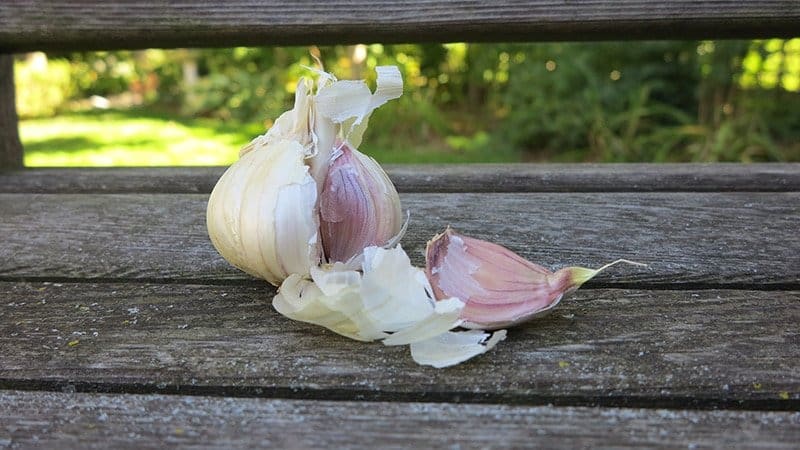I don’t grow many edibles for a few reasons. One, we’re fortunate to live near a farmers’ market and several roadside stands, so fresh, local produce is easy to find. Two, I use most of the square footage in our sunny raised beds for dahlias, other cut flowers and herbs. And three, the rest of our garden is shady and most vegetables need plenty of sun.
However, every October I always plant at least two dozen garlic cloves saved from a few of the largest heads I harvested in midsummer in a corner of one of the raised beds. These are a hard neck type (variety unknown), which means they produce a flower scape in June. Hard necks are more winter hardy than soft neck varieties, and even though each head produces only four or five cloves, they’re big, juicy and immensely flavourful. Unfortunately, hard necks don’t store as well as soft necks, but I usually run out of my homegrown garlic in late fall before any begin to spoil.

For me, garlic is foolproof and easy to grow. I space individual cloves, pointy side up, three or four inches (8 to 10 cm) deep and about four inches (10 cm) apart, usually in late October. When autumn leaves have been gathered and shredded by the lawn mower, I spread a layer of these over top of the garlic bed. A thin layer of soil or compost over the mulched leaves keeps the shredded leaves from blowing away. This is extra insurance, and I’m not sure if it’s truly necessary. In early spring, I start peeking through the mulch to see if sprouts are poking above the soil. When those are visible, I gradually pull off the mulch to let the stems reach sunlight.
For more information on planting and harvesting garlic, read “4 fabulous ways to harvest homegrown garlic” and “Looking for big garlic cloves.”
How to overwinter rosemary
Most of the perennial herbs I grow are hardy enough to overwinter in the garden; rosemary is the exception. It’s tricky to overwinter a potted rosemary indoors, and I’ve lost a few over the years. My challenge is to keep powdery mildew at bay until it’s warm enough in spring to set it outdoors again. Mildew doesn’t seem to affect plants when they’re outdoors. The plants I’ve lost in winter was likely due to inconsistent watering, which is something I learned about from “Overwintering rosemary.”
Saving cannas, dahlias and other tender tubers for next year
It’s difficult to say farewell to the glorious blooms and foliage of the cannas, dahlias, begonias and other flowering tuberous plants that have brightened up our gardens and patio pots this summer. If you have the space and the right conditions to store their tubers over winter, it’s possible to enjoy them again next year. Here are a few articles that will help you be successful.
“How to store calla and canna lilies”
“4 steps to overwinter tender plants” (Includes a handy chart for eight different plants)
“How to divide and store dahlia tubers”
Next week’s newsletter will focus on overwintering hardy perennials, roses and clematis growing in containers, as well as other timely tasks for the fall garden. Trust me, I don’t like to be the one to tell you this, but winter is definitely getting closer.








